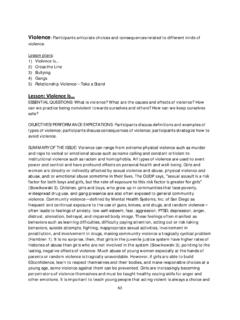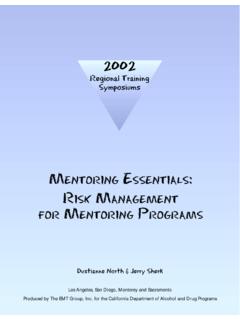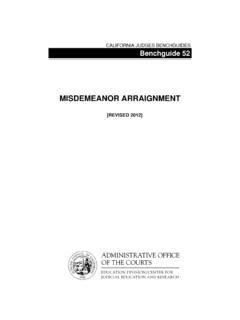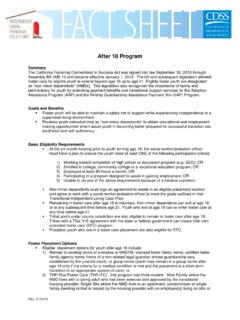Transcription of Enforcing Criminal or Juvenile Court Restitution …
1 WHAT IS Restitution ? Restitution is the recovery from an economic loss suffered as the result of the commission of a crime. Some examples of losses include: Medical Expenses Counseling Expenses Property Damage or Loss Loss of Wages WHAT ARE YOUR LEGAL RIGHTS? The California Constitution provides that Restitution shall be ordered in every case where a person is convicted of a crime involving a victim who suffered a loss. It is the intent of the Legislature that a victim of crime who incurs any economic loss as a result of the commission of a crime shall receive Restitution directly from any defendant convicted of that crime.
2 (Penal Code ) If the offender is a Juvenile , the parent or guardian is presumed to be jointly and severally liable for the Restitution owed. (Welfare & Institutions Code ) This presumption of liability is rebuttable and is subject to the limitations outlined in Civil Code and Criminal Restitution is a permanent order that does not expire and is not dischargeable through bankruptcy. (Penal Code 1214) Enforcing Criminal or Juvenile Court Restitution Ordersas Civil Judgments Bonnie M. Dumanis District Attorney San Diego County Vincent J. Iaria Chief probation Officer San Diego County Office of the San Diego District Attorney Restitution Enforcement & Victim Services Division 1 2 ENFORCEMENT OF JUDGMENTS A Criminal or Juvenile Order for Restitution is enforceable as a civil judgment (Penal Code 1214).
3 The law establishes procedures for the enforcement of civil judgments. More detail is available along with statutory obligations in the California Code of Civil Procedure through DEFINITIONS Garnishments: When a person s salary is intercepted by a levying officer and is given to the judgment creditor to satisfy a judgment Judgment: A judgment, order or decree entered in Court Judgment Creditor: The person in whose favor a judgment is ordered Judgment Debtor: The person that the judgment is ordered against Levy: A process to obtain property or cash from the judgment debtor to satisfy a Court judgment Levying Officer.
4 The sheriff or marshal who is responsible for making levies under a Writ of Execution Lien: A claim on property for payment for a debt Money Judgment: Part of a judgment that requires the payment of money Writ of Execution: A legal document issued by the Court that permits a levy on the judgment debtor s property Sister State Judgment: A legal document that allows a judgment issued in one state to be collected in another state under the laws established for conversion in that state. Enforcing YOUR ORDER The first step in Enforcing a Criminal Restitution order is to obtain an Order for Restitution and Abstract of Judgment (Form CR-110/JV-790) from the Criminal or Juvenile Court ordering an offender to pay Restitution .
5 Order for Restitution and Abstract of Judgment (CR-110/JV-790) This document is the actual Restitution order of the Court , signed by a judge. It identifies you as the victim and identifies the offender as the person who owes you a specific amount of money. You can file it with the County Recorder or request the assistance of an attorney, collection agent or other representative to file it for you and avoid filling in the personal information required by the County Recorder. The CR-110/JV-790 can be obtained from the records division of the Criminal / Juvenile Court that made the order. There is a possibility that you will have to prepare this document yourself if it has not already been completed.
6 The clerk will be able to provide the blank form or you can obtain it directly from The California Judicial Council website: CIVIL COLLECTION If you do not gain full Restitution through the Criminal courts, you can seek the assistance of a collection service or attorney. You may also choose to pursue collections personally. As a victim, you have access to all resources available under the law to enforce the Criminal Restitution order as a civil judgment. ASSET DISCOVERY HOW DO I COLLECT? If a Criminal or Juvenile offender is ordered to pay Restitution and is granted probation the courts usually pursue collection through local authorities.
7 The offender typically makes a monthly payment in an amount set by the Court that will be sent to you. The sentencing Court , the County Office of Revenue & Recovery, or the probation officer will be able explain the collection process if you have questions. If the offender is sent to the California Youth Authority (CYA) or is sentenced to the California Department of Corrections (CDC) you must fill out and submit a Victim Services and Restitution Collection Request Form to CDC (CDC Form 1707). Collection of your order will begin after this form is processed by CDC. Payments will be made to you from the offender s prison wages and trust account at the rate of 20-50%.
8 To obtain CDC Form 1707, you may contact the probation officer, district attorney, CDC s Office of Victim s Services and Restitution at 1-888-562-5874 or download it from CDC s website at: If the defendant is unwilling to pay Restitution , as ordered by the Court , you will need to know what his/her assets are to proceed with the civil collection process. A statement of assets from the defendant will assist you in determining what types of collection options to pursue. Defendant s Statement of Assets (Form CR-115) A victim is entitled to a copy of the CR-115 which lists the defendant s personal information, employment, assets, income and liabilities.
9 Request this form from the Criminal Court Records Division. If the defendant has failed to file the CR-115, you are entitled to a copy of the defendant s financial affidavit that was filed in seeking the appointment of counsel. In the event that a defendant has any unpaid balance remaining on a Restitution order 120-days prior to the expiration of probation or parole, the defendant must complete a new CR-115 and file it with the clerk of the sentencing Court no later than 90-days prior to release. (Penal Code (f)(5)-(11)) Form Interrogatories Crime Victim Restitution (Form CR-200) An interrogatory is a written question that must be answered by the defendant.
10 Under California Code of Civil Procedure (e), a victim with an unpaid Restitution order may annually send the CR-200 to the offender to determine his/her assets, income, and liabilities. These forms are available on the California Judicial Council website at: 3 4 Court Records If the defendant was previously involved in a lawsuit, has gone through a divorce proceeding or was a party to a child support action, the Court file could contain information about the defendant s assets. Court files are public record and you may request to review the file from the records division of the Civil or Family Court .













